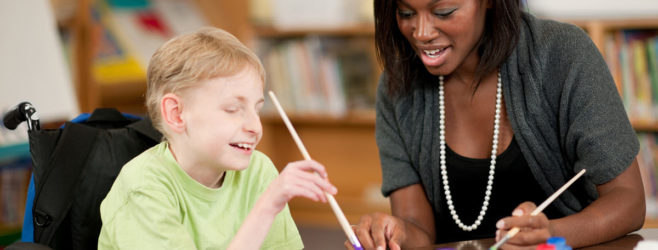Everyone has their own way of learning. Depending on our understanding of the world, we may perceive concepts, emotions, and situations differently from others. Even when exposed to identical circumstances, our minds don’t absorb information the same way.
Because of these learning differences, it’s crucial for educators to provide support systems tailored to each student’s needs.
Teaching Differently: One Size Doesn’t Fit All
The way students learn is influenced by a range of personal experiences and socializations, like cognitive and emotional developments, communicating in their native language, and the impact of possible abuse and trauma.
Since many of these variables are beyond our control, it’s important to note that students with atypical cognitive abilities require intensive intervention throughout their educational journey. These interventions can help both students and educators achieve new levels of success.
Students who have been diagnosed with disabilities related to a birth injury — such as brain damage, cerebral palsy, and Erb’s palsy — may need more support than what is generally provided within a traditional academic environment.
For example, a typical classroom may offer one curriculum for all students — without the flexibility, modifications, or alternative teaching methods that students with special needs would benefit from throughout the school year.
When this happens, students who need accommodations may feel excluded from their peers, frustrated at their lack of progress, and discouraged from continued learning.
Learning Differently: Adapting to Student Needs
“Schools are very accommodating nowadays,” shares Niousha Alamdar, a mental health associate who works with students enrolled in California’s Palos Verdes Unified School System.
“In my school district, students are allowed to change their schedules if particular classes are too difficult for them. We also take into consideration whether they need an easier class during certain times of the day, like early in the morning or after lunch.”
— Niousha Alamdar, mental health associate, California’s Palos Verdes Unified School System
Alamdar, who this semester is working with students on the spectrum and one student with a severe brain injury, explains that the goal of these accommodations is to support students in as many areas as possible to help them graduate.
“Some students have one-on-one sessions with teachers, some are transferred to continuation school, and some are given longer periods of time to complete their tests,” she says. “But the goal is to help them finish their primary academic journey in a way that best highlights their abilities.”
What Is a Multi-Tiered System of Supports (MTSS)?
A multi-tiered system of supports (MTSS) is a teaching framework many schools apply to their instruction and testing practices to assist struggling students. MTSS is especially beneficial for young learners, as early intervention can help them keep up with their learning.
With MTSS, teachers have the opportunity to set different learning objectives for students with diverse academic, cultural, behavioral, and social backgrounds.
Offering this extensive type of support promotes the wide-scale changes many schools need to implement in order to help all students, not just traditional learners.
Through the MTSS framework, all students have an increased chance of achieving academic success. This success should be measured differently based on each child’s unique gifts and abilities.
According to the Center on Multi-Tiered System of Supports at the American Institute for Research, the application of MTSS methods also relieves teachers of the pressures they face to improve learning outcomes for their students, even if some students score below proficient levels on exams.
Key Elements of MTSS Programs
Generally speaking, schools that support the MTSS framework screen students at the beginning of the academic year, as well as throughout the year, to determine their learning abilities.
These assessments help teachers, counselors, and school psychologists determine which students require additional support services in the classroom while keeping in mind that these students may also need special support for their behavioral, emotional, and social needs.
School staff must also receive sufficient training in these areas so they are well-equipped to care for these students.
Student Statistics: Education Accessibility
According to the National Center for Education Statistics, 7.2 million students between the ages of 3 and 21 received special education services under the Individuals with Disabilities Education Act during the 2020–2021 school year — a statistic that makes up 15% of all students enrolled in U.S. public schools.
Within this group of 7.2 million students nationwide:
- 33% have learning disabilities
- 19% have language or speech impairments
- 2–15% have other medical conditions that affect their learning, such as diabetes, epilepsy, heart disease, sickle cell anemia, and certain types of cancer
- Less than 2% have a combination of disabilities, including blindness, traumatic brain injuries, and visual and hearing impairments
Communication + Accommodation = Motivation
When students are encouraged to communicate their needs and their needs are met through accommodations, they are more likely to feel heard, understood, and valued — all of which can impact their self-esteem.
When students feel good about themselves, they are more likely to muster up courage and motivation to achieve their goals with the aid of their support systems.
If you have any questions about finding educational support for a child with special needs, contact one of our caring team members to learn more.



